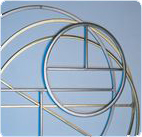Heat Exchanger GasketProperties and application
AdvantagesAvailable in a wide range of materials, since they are all custom made. There are few limitations regarding size and shape. Metal jacketed heat exchangers - The metal jacket provides mechanic strength to contain the filler and improves chemical resistance. Shape and constructionThese gaskets are used in shell and tube type heat exchangers. They can be manufactured in very different sizes, shapes, with or without bars. The primary seal is at the inner diameter of the gasket, the external gasket diameter acts as a secondary seal. The bars seal between the heat exchangers passages. The DONIT TESNIT® heat exchanger gaskets are produced in several types to meet the most demanding applications. Gaskets for heat exchangers can be manufactured in metal or alloy with a thickness of 0.4 mm featuring a soft core inside a metallic jacket. Spiral wound gaskets for heat exchangersThe spiral wound gaskets of MS10, MS12, MS14, or MS16 type can be manufactured with one or more metal jacketed bars (profile MP 10) in different shape shown in drawing. Metal-jacketed bars are welded and made of the same material as the spiral windings. The standard thicknesses are 3.2 mm, 4.5 mm and 6.5 mm. |

 Heat Exchanger Gasket is a term that has been given to gasket used in heat exchangers. The structure of the gasket or its type vary according to operating conditions of the exchangers. The DONIT TESNIT® heat exchanger gaskets come in a broad spectre of types including single or double jacketed, corrugated, plain metal, soft and many other. A large selection of different materials allows heat exchangers to operate at temperatures beyond the capabilities of most soft gasket materials.
Heat Exchanger Gasket is a term that has been given to gasket used in heat exchangers. The structure of the gasket or its type vary according to operating conditions of the exchangers. The DONIT TESNIT® heat exchanger gaskets come in a broad spectre of types including single or double jacketed, corrugated, plain metal, soft and many other. A large selection of different materials allows heat exchangers to operate at temperatures beyond the capabilities of most soft gasket materials.